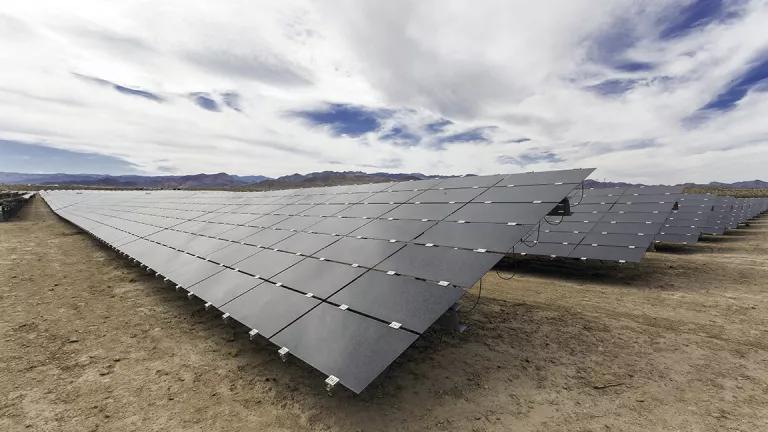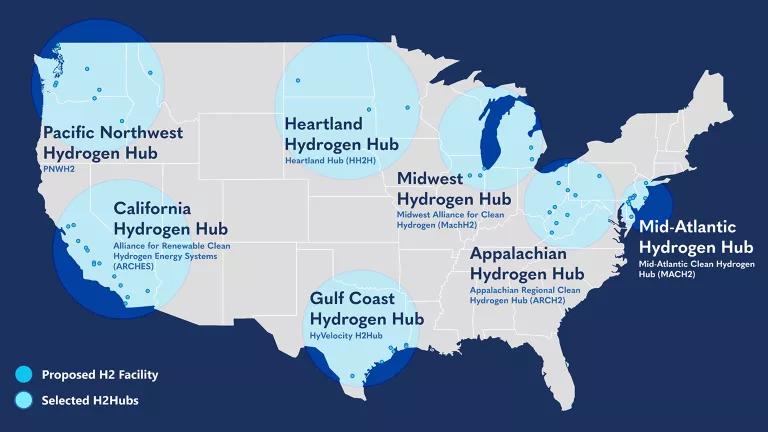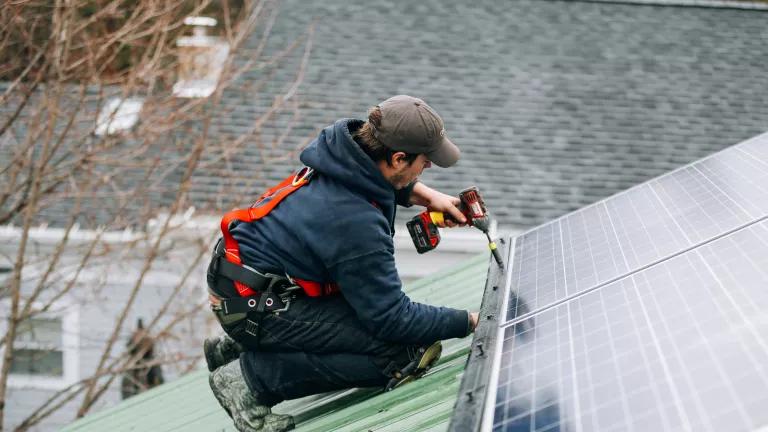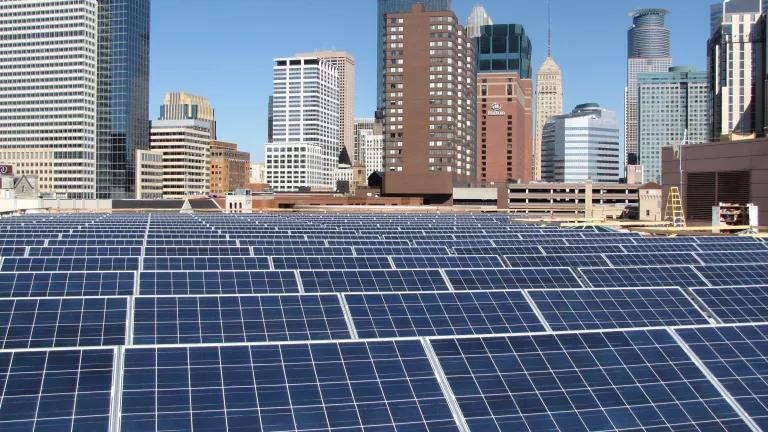Not Just Talk: Next-Level Community Engagement in Renewable Energy
How can we make clean energy infrastructure more compelling for communities to want to host it?

Moapa Band of Paiute Indians Utility-Scale Solar Array built on the Moapa Indian River Reservation in southern Nevada.
First Solar/Courtesy of DOE
This post is coauthored with Michelle Moore, author of Rural Renaissance and CEO of Groundswell, a 501(c)(3) that builds community power by eliminating energy burdens and increasing economic opportunity with community solar, resilience centers, residential energy efficiency, and pioneering research.
In 2022, the United States passed historic investments in clean energy solutions to help us confront the multiple, compounding crises we are facing: climate, nature, and inequality. To fully bring them to life, we will need a buildout of large-scale clean energy projects nationwide.
If done right, it can speed the transition to clean energy and help the United States meet its climate goals by the end of the decade. It can build wealth and improve people’s health in low-income communities and communities of color that have shouldered the highest burden of our fossil fuel dependence for too long. It can safeguard and restore nature and wildlife. And it can set us on a course for a cleaner, healthier, more equitable and prosperous future.
Critical to getting this right is involving local communities in the process early, often, and authentically, as well as ensuring the benefits from these projects—economic and environmental—flow to the local communities that host them. Yet, when it comes to the relationship between renewable energy facilities and the communities being asked to host them, there are a couple of things we know for sure.
First, we know that local opposition to these projects is common and increasing, often due to outside dirty energy interests’ agitation. Every year, researchers at Columbia Law School’s Sabin Center for Climate Change Law issue a catalogue of opposition to renewable energy projects around the nation. The 2024 edition documents 378 contested projects, which it characterizes as a “major increase” over the totals in the 2023 edition. Researchers have found that once renewable energy projects are initially blocked by local opposition, only about 13 percent of them are ever completed.
Second, we know that the world is awash in recommendations about how renewable energy developers should interact with host communities to ensure fairness and ensure health and economic opportunity are prioritized equally with climate concerns.
The concept of “smart from the start” has achieved buzzword status in government and environmental advocacy circles, referring to the hard-to-argue-with concept of using careful planning and community engagement at the early stages of a project to minimize conflict and address community priorities.
There are also multiple recent publications aimed at guiding renewable energy developers in best practices for engaging with local communities where projects are located, offering largely procedural advice. Americans for a Clean Energy Grid’s recommended siting practices for electric grid development (an essential part of renewable energy deployment, as outlined in NRDC’s recent Down to the Wire report) focuses substantially on early and consistent engagement with communities, as well as respectful and fair treatment for those communities—including codes of conduct, carefully chosen representatives, frequent and well-run meetings, and dissemination of complete information. Best practices recommended by the National Renewable Energy Laboratory include preparing well for community interactions, being “humble, authentic, and honest,” respecting community agency, and democratizing participation.
These commonsense recommendations should be endorsed and implemented by project developers everywhere. But what if they are not enough? What if the hundreds of projects documented by the Sabin Center that are facing local opposition reflect substantive concerns about being asked to host energy infrastructure that will require an equally substantive response to overcome?
Research suggests that these concerns are, indeed, pervasive drivers of opposition. A 2022 MIT study that reviewed 53 delayed utility-scale renewable energy projects in depth concluded that most siting controversies flow from multiple definable stakeholder concerns. Procedural inadequacies gave rise to opposition in 28 percent of the cases studied; but local environmental concerns were at issue in 60 percent of cases, tribal rights in 23 percent of cases, diminished land value in 62 percent of cases, and perceived health impacts in 26 percent of cases.
The fact that community members are coming to the table with specific and understandable worries about industrial-scale projects slated for construction in their agricultural, remote, frontline, or pristinely rural communities suggests that better engagement procedures may be necessary, but not sufficient.
The reality is, we need to build out clean energy infrastructure, and someone, somewhere is going to have to host it. But the question we should be asking ourselves is not how can we do a better job of convincing potential host communities that they be fine with that, but rather, how can we make them more compelling for communities to want to host them? To do that, we must build a good process to identify substantive concerns and then meaningfully address them with mitigation and compensatory benefits. That is, in fact, fundamental to rebuilding our energy systems with justice as a core value, instead of replicating the economically extractive and unjust systems we still struggle under today.
Charting a path toward this vision will take time, patience, research, the expertise of local communities, and the lumps and bumps of hard-won experience. But even now, potential strategies for recognizing the value of hosting renewable energy projects by sharing economic, ownership, and other benefits with local communities are emerging. Here are some of them:
- Co-ownership. Local community and tribal project hosts can be granted a beneficial economic stake in renewable energy projects. This is an idea that has been contemplated for a while among advocates and deserves closer analysis and development. Certainly, there are any number of complexities that would need to be worked out in order for this practice to become widespread: regulatory structures, risk management, and the like. But we already have a shining example of how well a co-ownership strategy can work in the deal that was struck between Southern California and the Morongo Band of Mission Indians for Morongo Band co-ownership of the West of Devers Line, a key renewable energy conduit to Southern California urban centers.
- Labor benefits. Another means of ensuring that communities benefit economically from renewable energy projects is to ensure that local labor is given first chance at the jobs they generate. This can be achieved through use of project labor agreements—which result in a tax break for developers under the terms of the Inflation Reduction Act. Offshore wind developers are also investing in work force development as part of their bids to win contracts.
- Electrification cobenefits. Many rural communities—and in particular tribal communities—in areas slated for renewable energy and transmission development lack basic access to reliable energy. It is fundamentally absurd that anyone in America lacks access to electricity, but tens of thousands of our neighbors don’t have any power at their homes. And it is a fundamental imperative to ensure that improvements to our energy system benefit the communities who are being asked to host them. As renewable energy infrastructure is being developed in these geographies, it can offer local access to energy and improve the ability of local distribution systems to connect to generation and the grid.
- Impact mitigation. Renewable energy infrastructure does not result in the severe health and environmental damage associated with fossil fuel development. But it is not impact-free. Good planning can minimize impacts, but construction can be disruptive, and neighboring residents have reasonable concerns about potential impacts on their view, the landscape, and local wildlife. Fortunately, there are already many tools available for mitigating these impacts, which should be implemented as a best practice and always offered to local communities. We should also continue to develop our ability to underground portions of transmission lines that would otherwise have major visual or other impacts if they are strung above ground.
- Tribal sovereignty. Renewable energy and transmission development often affects tribal land and communities, given their usual location outside of major urban centers. It is essential that regulators and developers consistently treat tribes as the sovereigns they are and engage with them as coequal governments, rather than approaching them as just another set of stakeholders. Tribal engagement done poorly has resulted in project delays, but respectfully addressing tribal sovereignty has been the basis for groundbreaking efforts such as the Morongo Band co-ownership deal.
- Community benefits agreements. Community benefits agreements (CBAs)—negotiated directly with community-based organizations and enforceable in the same manner as any contract—are one available tool for developing and memorializing local benefits. These are not to be confused with community benefits plans, which are a form of project labor agreement, or host agreements, made with the local government. While both of these have their place, CBAs can be one route for cementing community benefits. The Bureau of Ocean Energy Management set a leading example by offering a 5 percent credit to offshore wind developers who commit to developing a CBA.
Clearly, some of these strategies will raise project deployment costs and impact the bottom line. It’s important that renewable energy projects remain economically feasible, and it’s also important that renewable energy project economics recognize the value of hosting the project—correcting the extractive economic relationship that fossil fuel infrastructure has had with the people and local communities that have had to bear the economic, health, and environmental burdens of powering our national prosperity.
When done right, renewable energy can be the rising tide that lifts all boats.



